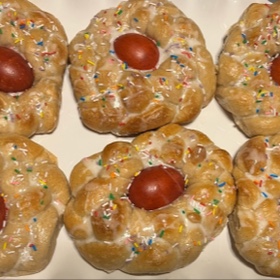Ingredients
10 raw eggs
2 cups starter
1 cup milk
4 T. Butter
1/2 cup sugar
3 eggs + 1 egg yolk, beaten
2 tsp. salt
1 tsp. Nutmeg (optional)
1 tsp. Cinnamon (optional)
1 tsp. Ginger (optional)
1 T. Vanilla extract
3 cups bread flour
Additional bread or AP flour
Kitchenaid mixer with dough hook
Lightly oiled container
Large baking sheet
1 Egg white + 1 tsp. Water
Large pot
Yellow onion skins
Red food coloring (optional)
Description
An Orthodox Easter tradition in Greece.
Directions
Orange-Red/Orange/Brown eggs:
The color you get with this method will vary more than the second method below; the advantage is that this method produces eggs that are still good to eat. If you want the eggs to be more red than they turn out, you can add a few drops of red food coloring and return them to the fridge for a few more hours.
Fill a large pot with water and as many yellow onion skins as you can get your hands on (If you have some white and red, throw those in too). If you keep all of your peels for a year, you may have enough. You can also pick up loose onion peels when you buy onions at the store; they may raise their eyebrows, but they won't care.
Bring the water to a boil, then turn the heat down to maintain a simmer. Simmer until the color is nice and dark, about 60 minutes. Add peels and water as it cooks down if your pot isn't big enough to fit them all in at once.
Let the water cool completely. Strain and add 2 tablespoons of vinegar. If you have a lot more than you need, you can cook it down to concentrate it, then let it cool again. Put the raw eggs in a bowl or container and pour the water over. Cover and put in the refrigerator overnight.
Traditional red eggs:
This method is traditional, but produces overcooked, inedible eggs. You'll want to throw them out rather than eat them.
Fill a large pot with water and as many onion skins as you can get your hands on and cook them as above, until the color is nice and dark. Add the eggs to the water and boil until the eggs are a rich red color, adding water as needed. If your eggs are not turning as red as you would like, add a few drops of red food coloring.
Remove eggs with a slotted spoon to paper towel or a cardboard egg carton and let dry.
Dust off any stray onion bits after the eggs are dry. Refrigerate until you are ready to make your bread if you aren't ready to continue yet.
Make your bread:
In a saucepan, warm your milk and butter on low heat and dissolve the sugar in it. Let cool.
To your starter, add the milk, eggs, and the bread flour. Mix thoroughly, until smooth, cover and let sit at least 1 hour.
Add the salt and vanilla. Add the nutmeg, cinnamon, and ginger if you are using them.
Incorporate additional flour a little at a time until you have a doughy ball.
Turn out onto a floured board, sprinkle with flour, and knead until you get a nice springy ball that leaves no fingerprints when pressed.
Put in an oiled, marked container and let rise until doubled, 2-4 hours.
When it comes time to shape the loaves, pull the dough out onto a clean surface. Divide the dough into 6oz. pieces.
Divide each doughball into three ropes and braid them, or into two ropes and twist them. (If the dough is too springy to roll out, let it rest 10-15 minutes).
Curve them into rounds and pinch the ends together. Line up on a large baking sheet lined with a silicone mat or parchment not quite touching.
Lightly oil, cover loosely with plastic wrap, and refrigerate overnight.
Pull out and tuck the eggs into the centers. Let sit until no longer cold to the touch and somewhat puffed, about 1 hour in a warm spot. If the eggs sweat, pat them dry with a paper towel.
Heat the oven to 350 degrees. Whisk your egg white and water.
Brush the dough with the egg white, and bake for 20 minutes.
Brush with egg white again, and bake another 10-15 minutes. Your bread should be golden and shiny.
Move to a cooling rack. If desired, after the bread has cooled a bit, drizzle it with a simple powdered sugar glaze and dust with sprinkles.

Unfortunately these can't stay pretty forever. Once the bread has completely cooled, pull the eggs out, rinse them, and put them in a bag in the fridge to use in something like egg salad. Put the bread in a bag or container or plastic wrap it, and store at room temperature. Warm a little in the microwave before eating.
Use one as a nice Easter table centerpiece... just don't eat it later.
Notes
While it is not traditional, it is very pretty if you use Easter egg colors instead.
*Sweet doughs are slow risers, so don’t worry if it takes longer than stated.
